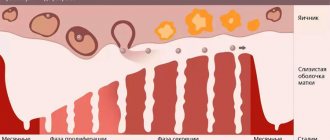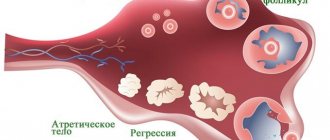Blood during ovulation
Causes of discharge during ovulation
Most people mistakenly think that blood during ovulation indicates that conception has occurred or begin to confuse it with implantation bleeding. But in reality, the situation is that the period of time between implantation and ovulation is 5-7 days, due to this fact there is no connection between them. Also, the cause of blood during ovulation is the rupture of the follicle, a mature egg should come out of it. Immediately after the start of the entire cycle, the eggs begin to mature in the ovaries, and the eggs themselves are located in follicle capsules. Over a certain period of time, a leader will emerge among these follicles, and a mature egg will emerge from it. This outlet may reveal minor discharge. But they are usually brown, anne red, as usual during menstruation. There is another explanation for everything that is happening. Blood during ovulation may appear due to hormonal changes in a woman’s body. Before the ovulation process, when the follicle in which the egg matures grows, the female body produces large quantities of estrogen. And an increased level of the hormone estrogen leads to the release of LH (luteinizing hormone), which in turn allows the follicle to release a mature egg. And the peak in estrogen levels before the ovulation process causes small discharge at this time. In total, all discharge appears a few hours before ovulation and will continue for about two days after it ends. They usually appear as minor bleeding or small, one-off spots on a woman's underwear. The latter can be difficult to distinguish from egg white (cervical fluid). But there are many other reasons for such discharge, but in most cases the cause is the ovulation process.
Learn more about types of bleeding
Such bleeding outside the menstrual period occurs in many women and is normal. Basically, there are 2 main types of bleeding in the time interval between menstruation, these are intermenstrual bleeding and metrorrhagia. Bleeding between two periods is intermenstrual bleeding, and heavy uterine bleeding is metrorrhagia. Doctors also identify some other reasons why blood appears in a woman’s body during ovulation: depression or stress, vaginal trauma or vaginal infections, inappropriate medications. There are also additional reasons, such as: taking or not taking supplements with the hormone estrogen, taking or not taking birth control pills, the presence of an intrauterine device in the body, miscarriage, changes in general hormonal levels, the presence of low levels of thyroid hormones. If you experience such discharge and bleeding, it is recommended to rest more time and try to avoid a variety of stress and depression. If bleeding during ovulation is caused by diseases, then undergo immediate treatment.
Is it possible to experience blood during ovulation?
Discharge during ovulation may contain blood, since during the release of the egg from the follicle it ruptures. They are most often the norm, but they should be sparse, pink or light brown. In appearance, they are completely different from menstruation, most often their consistency is not uniform, they can be light with red streaks. Should last no more than 3 days.
However, the absence of blood clots during ovulation is not a pathology. After all, every woman’s body is individual, so the ovulation process occurs differently for everyone. And don’t worry too much if you previously had no visible blood streaks during the release of the egg, and then everything changed. After all, changes in the body can occur at any time, but they are not always noticeable.
Some doctors even believe that blood appearing during ovulation indicates a woman's good health. After all, slight bleeding indicates that the egg has left the follicle, which means that the reproductive system is working normally.
How to distinguish periods from implantation bleeding?
After ovulation and fertilization, the egg (which is called a blastocyst) completes its movement through the fallopian tube and implants into the lining of the uterus. For some women, implantation may cause slight bleeding or spotting. This is called implantation bleeding. The signs of this condition are very similar to regular periods, which is why such discharge is often confused.
What does implantation bleeding look like? How long does it last?
These discharges, which accompany the implantation of a fertilized egg into the uterus, often last no more than a few days, more often it is a couple of hours.
The color is pinkish or red, but not saturated. The nature of the discharge is spotting - not as heavy as during menstruation.
What day does it start on?
Implantation usually occurs 6-12 days after ovulation and fertilization.
Compared to monthly bleeding, this type of bleeding usually begins a week or a few days before your period. If you keep a “calendar” and regularly record the beginning and end of your periods, you will definitely be able to notice that you are not having normal menstruation. This is why it is so important for women who monitor their sex life and care about their health to make these notes. Also remember that normal periods start weakly and increase in intensity the next day (there are women who do not experience heavy bleeding every month, so you need to know the characteristics of your body). Implantation bleeding does not increase in severity and continues to be minor for several hours (days), and then generally goes away quickly.
Sometimes bleeding due to implantation begins precisely during the period (even on the same day) when the next period was supposed to start. In this case, it is even more difficult for a woman to determine what it is: pregnancy has already occurred or just preparation for the possible next ovulation. Only wait-and-see tactics will help here, and if there is no discharge the next month, then we can safely say that the last time it was the implantation of a fertilized egg into the uterus.
If you suspect that pregnancy has occurred, then 10 days after ovulation you can try to get tested for hCG (in some cases, especially sensitive pregnancy tests can show a positive result - if you are not mistaken, of course).
Implantation or menstruation?
Implantation bleeding is a fairly common occurrence during pregnancy. Approximately 20-30% of women experience spotting in the early stages. This is why many girls continue to not even suspect that they are pregnant, because they believe that this discharge was a manifestation of menstruation, which is actually an illusion. Implantation bleeding is an early sign of pregnancy. By the way, immediately after attachment to the uterine mucosa, the blastocyst becomes an embryo.
There are also a number of other causes of bleeding during pregnancy, which you can find in our article.
Is ovulation possible without menstruation?
Women who are wondering whether ovulation can occur without menstruation believe that these concepts are closely related. But in fact, gynecologists prove the opposite. In practice, there are a large number of situations when the expectant mother finds out about her pregnancy despite the fact that she has not yet had “women’s days”. It is these cases that act as evidence that ovulation is a natural state that can occur independently of menstruation.
Ovulation without the onset of menstruation can occur in the following cases:
- Lactation. Unexpected ovulation sometimes occurs during lactation or after childbirth. In certain cases, pregnancy occurs during breastfeeding, but this happens rarely. While the child is fed with mother's milk, her estrogenic function does not work, which is why the eggs do not mature and ovulation does not begin.
- Failure in menstruation. If “women’s days” do not occur according to schedule, ovulation still occurs. This picture, as a rule, appears in the case of menopause or in the first time after menopause.
- Ovarian dysfunction. An equally common phenomenon that can lead to the absence of menstruation. This pathology develops against the background of disorders in the endocrine system, so the cause should be looked for there.
- Deviation of body weight from the norm. A woman's overweight or underweight also occurs due to a lack of menstruation. As a rule, this does not interfere with the onset of ovulation. But the solution here is very obvious - it is necessary to bring body weight back to normal and all body systems will begin to work as usual.
Your period started and ended immediately - reasons for early menstruation
Abnormal menstruation is always a cause for concern. Your period started and immediately ended - a situation that is surprising and requires explanation. If a normal menstrual cycle is a sign of good female health, what is wrong with a woman's body?
Normal length of the menstrual cycle
The countdown of a new menstrual cycle begins from the moment menstruation appears. At the same time, the body is cleansed, restored, and renewed. It takes 12 to 16 days for the egg to mature. After which the egg, ready for fertilization, is released from the follicle. After ovulation is completed, a woman’s body begins to prepare for pregnancy, regardless of whether fertilization has occurred or not. The endometrial layer gradually thickens. The future fetus should develop in the protected uterine cavity. This happens for about a week. Then the body understands that there is no pregnancy and prepares for menstruation. The menstrual cycle repeats again.
Hormones affect blood circulation in the pelvic organs. Before menstruation, progesterone levels decrease significantly and estrogen remains low, which contributes to greater fragility of blood vessels. The vessels dilate and bleeding appears. At the same time, the endometrial layer is gradually rejected. In menstrual flow it looks like clots. The reproductive system is again preparing for pregnancy. It takes 3–5 days to cleanse the uterus and release stagnant blood. This is how long normal periods last. If the duration changes up or down, this is considered a deviation. It’s puzzling when your period just started and ended again.
Rapid menstruation - causes of menstrual irregularities
The main and most important reason for changes in the duration of menstruation is hormonal imbalance. Pathology can affect both the first half of the menstrual cycle and the second. If there is insufficient estrogen in the first phase of the menstrual cycle, there is no ovulation. Then the duration of the entire monthly cycle and menstruation changes. At the same time, one should not confuse the body’s normal break from pathology. A healthy woman under 30 years of age has about 2-month cycles without ovulation. In such cases, menstruation is somewhat delayed, and the nature of the discharge changes. My periods are less intense, but there are no significant changes. Hormonal imbalance with too low estrogen levels prevents the normal formation of the endometrial layer. It doesn't grow. When the time comes for rejection, there is, in general, nothing to reject. That's when quick periods appear for one day.
Hormonal imbalance in the second phase of the menstrual cycle can also cause pathology. Under the influence of progesterone, the uterine layer of the endometrium continues to thicken. On the eve of menstruation, the uterus uses sedentary muscles to reject it. Under such conditions, menstruation occurs. With insufficient amounts of progesterone, uterine activity decreases and the endometrial layer does not renew itself as needed. Instead of normal menstruation, rapid periods appear for one day with brown spotting. A few drops of blood on underwear in most cases remains unnoticeable. The woman generally believes that the delay has been going on for too long.
Factors of menstrual irregularities
To find out the cause of the failure, in some cases it is enough to analyze the events of the past month.
- The most common and most harmless reason for violation of the duration of critical days is nervous fatigue. The female body is a very complex system in all understandings. The central nervous system is responsible for the nature of discharge during menstruation. A month that is unsuccessful in the emotional and psychological aspect becomes a common cause of violation. Once your period begins, it quickly ends. Stress, quarrels, scandals, depression, constant nervous tension lead to exhaustion of the nervous system. But it is she who regulates the production of hormones in a woman’s body.
A sharp change in climate and time zone causes menstrual irregularities. The body is under stress. In this case, the hormonal levels change. Instead of normal critical days - fast periods. In the process of adapting to new living conditions, the body recovers. Or the menstrual cycle returns to normal after returning to their previous place of residence.
- Menstruation for one day often appears under the influence of hormonal drugs. Birth control pills prevent ovulation and prevent the formation of a full layer of the endometrium. The amount of discharge during menstruation decreases, to the point that the menstruation that has begun immediately ends. During the adaptation process, this situation is considered normal. The time allotted for the process of getting used to new conditions is 3 months. Further violation of duration is considered pathological.
- Pregnancy can also cause a sharp reduction in days. Then brown discharge appears in small quantities due to unstable hormonal levels. In addition, the sudden onset of menstruation in the case of pregnancy can mean its failure or ectopic implantation of the egg.
- Having an abortion last month changes my hormonal levels significantly. Then both uterine bleeding and scanty discharge are possible. In the absence of infection or inflammation, the menstrual cycle is restored on its own the next month.
- Diseases of the endocrine system, pathology of the adrenal glands, ovaries, and liver change the hormonal background of a woman. Your periods are shorter than usual or there is uterine bleeding.
Treatment with antibiotics and drugs that affect blood clotting changes the nature of the discharge. The pathology resolves on its own when you stop taking the medications.
- Diseases with an increase in temperature - acute respiratory infections, influenza, tuberculosis disrupt the ovulation process, delay critical days, and change the nature of discharge.
How to determine ovulation
Often women do not feel the signs of egg maturation and have no idea whether it has happened or not. Many people are not interested in knowing this, but for couples who dream of having a child, determining when ovulation has occurred becomes mandatory.
Let's look at what methods are used.
Calendar method
The simplest method in which the development of the female reproductive cell is calculated using an ordinary calendar. The girl will have to mark the start and end date of her period there for six months.
It is necessary to count the number of days between the first days of the cycle in 2 consecutive months. Subtract 14 from the resulting value and get the day of ovulation. For example, if the cycle is 28 days, then on the 14th day the mature egg is released from the follicle.
The method is good for women who have a regular menstrual cycle. Otherwise, there is a high risk of incorrect calculation: it is difficult to predict the number of days if in 1 month it is 26 days, and in the next - 34.
When a girl does not want to make calculations, you can use an online calculator by requesting it in a search engine. He will quickly indicate the cherished day.
Ovulation tests
A device for determining ovulation can be purchased at a pharmacy. The principle of action is designed to respond to increased levels of luteinizing hormone in the urine. The concentration of the substance begins to increase 1-2 days before the egg leaves the follicle, so tests are used several days before expected ovulation.
For research you need to follow some rules:
- You should not use your morning urine sample. It is better to collect urine from 10 to 20 hours.
- Do not drink liquids for 4 hours before testing.
- Two hours before the test, refrain from going to the toilet.
- Read the instructions carefully before testing.
When the test is performed correctly, the method is quite accurate.
Determination of basal temperature
Temperature measurements are taken in the rectum in the morning immediately after waking up. On the days when the egg leaves the follicle, it is higher than on normal days. Outside of ovulation, it is 36.6-36.9 degrees, and on the cherished day - 37 degrees. To record fluctuations in values, a calendar is compiled, with which it is possible to predict the maturation of the female reproductive cell.
The method accurately shows ovulation in girls with a regular menstrual cycle. If a woman’s temperature fluctuates, instead of measuring basal temperature, you should use another method.
A rise in basal temperature is possible with inflammatory diseases, short sleep, taking alcoholic beverages or medications. All features must be taken into account.
Medical diagnosis
This is the most accurate definition of ovulation. The gynecologist examines the woman in a special chair, where she observes changes in the cervix: it softens and opens slightly.
Additionally, ultrasound diagnostics is performed. During it, the fact of ovulation and its stage are determined. Ultrasound is performed from the 10th day of the menstrual cycle. In order for the doctor to track the growth of the dominant follicle, the girl needs to come for the study more than once. When the mature egg is released from the ovary, the resulting corpus luteum can be seen on the monitor.
Medical diagnosis is resorted to when a woman has had several unsuccessful attempts to conceive a child over a long period of time.
Why there may be spotting instead of menstruation - reasons
A regular and full menstrual cycle that repeats without interruption indicates that the female body is in perfect order and there is no reason for concern. But if the menstrual cycle is disrupted, there is a serious reason for concern. Cycle failures have various causes and various manifestations. One of these manifestations is spotting instead of menstruation.
Spotting can have several causes and is often a pathology. Factors influencing the appearance of spotting on the day when your period is scheduled to begin:
Woman's age
Also, if a woman is over forty years old and begins premenopause, then the appearance of spotting instead of menstruation is a sign of a natural decline in the functionality of the ovaries. During this period, the ovaries no longer function at full capacity.
Currently, the period of premenopause may occur in younger women (37-38 years old). The decline in the functionality of the female reproductive system at this age is influenced by a large number of external and internal factors, as well as genetic predisposition.
Regular sex life
If a woman had sexual intercourse several days before the onset of menstruation, and did not use contraceptives, then she needs to be checked for pregnancy. Spotting may appear due to the onset of pregnancy.
If the presence of pregnancy in the body has been established, and spotting continues to appear, then you should immediately consult a gynecologist for advice. Spotting in this case is a sign that the body does not produce enough hormones that are vital for the developing embryo.
A particular danger in the presence of pregnancy is daubing, which occurs from the day when according to the schedule they should start
Source
Menstruation without ovulation
Menstruation can also occur in the absence of ovulation. It does not occur in various ovarian pathologies. For ovulation to occur, it is very important that the hypothalamus and pituitary gland function correctly. The latter is responsible for the production of hormones, and the former inhibits this process if a woman is stressed.
The reason for the lack of ovulation may be incorrect functioning of the thyroid gland. It is also responsible for the production of hormones and reproductive function. If the thyroid pathology is serious, then menstruation may stop altogether. In this case, you need to consult a doctor.
Transparent selections
A woman's menstrual cycle is divided into three phases. The first phase is the follicular phase, when the follicle matures, which will subsequently release an egg. During this entire period, estrogen “commands” the body of the fair sex. Under their influence, on the eve of ovulation (the release of a mature egg from the ovary) and during it (two to three days in the middle of the cycle), most women experience a significant increase in clear mucous discharge from the vagina. This is how nature promotes pregnancy as quickly as possible. After all, ovulation and a few days after it are the most favorable period for conception. Right now, abundant mucous secretions will help male cells reach the fallopian tubes, passing through the cervix and the uterus itself. And there “meet your other half.”
After ovulation, the menstrual cycle begins when the hormone progesterone takes control instead of estrogen. The purpose of this stage is to secure the fertilized egg in the uterine endometrium. In the second phase of the menstrual cycle, the discharge from the genitals becomes much thicker and instead of transparent it becomes milky white. This is explained by the fact that the body thus protects the entrance to the uterus from infection. If there is no pregnancy, the inner layer of the uterus is rejected and after that everything starts all over again. At a time when changes occur in a woman’s body, indicating that menstruation is approaching, estrogens again take over and the amount of clear discharge increases significantly a few days before the onset of menstruation. But they still remain quite thick, because progesterone is still active.
This frequency of discharge in the female body is absolutely normal and physiological. On the walls of the vagina and cervix of a woman there are glands that produce a mucous secretion that maintains hydration and controls the microflora, creating conditions for the development of lactation.
Source
Pathological discharge
When clots or streaks of blood appear, do not panic and immediately consult a doctor. To begin with, you should pay attention to the nature of the departments, and especially to the following signs.
- Blood is released during ovulation, but the duration exceeds 3 days.
- Bleeding that continues for more than three cycles in a row.
- In addition to bleeding, there is pain during sexual intercourse or shortly after it.
- Heavy periods.
- Unpleasant smell.
- Visually noticeable clots during ovulatory discharge.
- Any other deviations from the normal course of the menstrual cycle.
Changes in the nature of the secreted fluid may be a sign of gynecological diseases. Most often, patients who have bleeding are diagnosed with uterine fibroids or endometrial polyps. These diseases can cause blood to appear between menstrual periods, which some women mistakenly take as a sign of ovulation or an early period. And although these pathologies require surgical treatment, they are not very dangerous for a woman’s body until a certain point.
But there are other diseases that can cause abnormal bleeding. For example, an ovarian cyst. If such a cyst is present in the dominant follicle, this can lead to the fact that timely rupture does not occur during ovulation. But at the same time, the follicle, during its growth, begins to compress the walls of the tumor, which is the cause of bleeding.
A cyst develops due to several factors: hormonal imbalance, contraceptives that suppress progesterone production, prolonged absence of intimate life, and others. The follicle, which has grown to its limit, eventually ruptures, and does this together with the existing cyst. In this case, symptoms such as sharp pain in the lower abdomen, nausea and dizziness appear. And the separation is more abundant than menstruation. This pathology is very dangerous for a woman, as it threatens serious blood loss and requires urgent use of hemostatic drugs, and sometimes surgical intervention.
In inflammatory diseases of the reproductive system, bleeding is accompanied by a sharp and unpleasant odor from the vagina. Pain, burning and itching may also be present, and patches of pus may be present during menstruation.
Less commonly, bleeding can be caused by ovarian apoplexy, cervical erosion, or injury to the vaginal mucosa. With apoplexy, bleeding is profuse and accompanied by severe pain. This condition is dangerous because blood may be released not only into the uterine cavity, but also into the abdominal cavity, and this requires urgent intervention by a surgeon, otherwise it can lead to the death of the patient. When the mucous membranes are damaged, the woman begins to feel discomfort when walking or sitting. And erosion leads to pain during sex or after physical activity. These 3 pathologies are similar in that their appearance is often caused by rough and harsh sexual contact.
But not only diseases lead to pathological discharge. Incorrect selection or use of hormonal contraceptives can cause bleeding, which is called breakthrough bleeding. Also, this may appear at the beginning of taking medications, while the body is just adapting to them.
Also, some medications can cause bleeding. These are mainly emergency contraceptive drugs, such as Postinor or Escapelle. The fact is that they contain a very large amount of sex hormones and, when taken, cause an endocrine shift.
Discharge with blood that occurs during the release of the egg is normal and does not require a visit to the doctor. However, if this happens for the first time, then you should observe the course of the cycle for some more time in order to notice other changes in time, if any. If you have any suspicious symptoms, you should visit a gynecologist to prevent the emergence or further development of diseases of the reproductive system.
The article was checked by a practicing family doctor, Elizaveta Anatolyevna Krizhanovskaya, 5 years of experience More about the author
(you can vote for the article)
Tags: discharge in women, bleeding, ovulation
- Related Posts
- Adhesions: treatment with folk remedies
- How does premenstrual syndrome manifest in women?
- What to eat on each day of the cycle to lose weight: diet for menstruation
What could be the reasons for the appearance of menstruation with mucus and clots?
Every woman should know that periods with mucus are considered completely normal. A similar process is typical for every organism. Although such knowledge is part of life, it is still worth paying special attention to the amount of the substance released, as well as its consistency. Doctors admit that in some cases, the appearance of mucus during the menstrual cycle is a symptom of some health changes. Often the cause of this is illness.
1 What you need to know about mucus
Typically, the mucus that appears during menstruation is formed in the cervix. The organ responsible for its secretion is the endocervix. It is located in the cervical canal. Its surface is made of epithelium, in which glands with the same name are located. The production of mucus is a product of their activity. The main attention should be paid to the fact that during one menstrual cycle, mucus of varying thickness may be released . The consistency depends on the woman’s mood and her hormonal state. The glands produce it to facilitate the entry of sperm into the uterus.
Signs of menstruation without ovulation
Initially, it is worth understanding whether there is really a reason for concern. If the duration of the menstrual cycle is 24-30 days and menstruation comes on time, then the woman has no problems with ovulation. When a failure is observed, it can be assumed that the ovaries are not working correctly.
It is very difficult to recognize anovulation without examination results. Such menstruation often occurs without any external signs. A gynecologist will give more accurate answers to these questions. He will suggest taking a blood test for hormones.
Why did I get my period on the second day after the days of ovulation?
In general, my period started on 08/07/2012. It ended on 08/12/2012 (at the same time, I always strictly after m. I count the days of ovulation). It turns out that the days of ovulation in a 28-day cycle were from 17.08 to 22.08.. And yesterday (24.08) my brain almost burst from the fact that when I woke up in the morning, I discovered that I had a heavy period ( at the same time there is no pain, for me it usually goes away painfully). And to this day I still have my periods with some rare clots. I'm just shocked, I get my period twice a month. And so plentiful.
Go to the doctor. and on ultrasound. What if it’s a cyst or something wrong with the endometrium? There should be no menstruation in the middle of the cycle. even ovulatory discharge with blood clots, a one-time occurrence, is not the norm!
In your case, it’s very similar to dysfunctional uterine bleeding, since it’s profuse... You definitely need to find out the cause, you still need to see a doctor, but in general it would be ideal if they scraped it out and did histology... Then you would know exactly the cause of the discharge... It could there may be a hormonal imbalance, a cyst, or endometrial hyperplasia... All these conditions require correction, otherwise there will be no problem...
[email protected] , Innochka gave you the most effective advice... I also don’t understand such copious bloody discharge during ovulation...
Margaritka85, by what criteria did you understand that it was O.? If it’s just by the days that it should be at 13-14, then it may very well be that there was no ovulation at all and there was a violation. The breasts could swell due to hormonal imbalance. You need to go to the doctor.
Most likely there is a hormonal imbalance, which is why the breasts are swollen. And counting “ovulation days” is simply stupid if you haven’t tracked it using ultrasound. Are you sure this is happening to you?
I had a similar situation, only my periods came three times a month: (I signed up for an ultrasound, they said h
Source
Why are my periods brown?
The norm for a woman of reproductive age is to have menstruation every month. Menstrual discharge, bloody in nature, with a specific odor, red in color, and possibly the presence of blood clots is normal. In the uterus, the process of detachment of the endometrium, the mucous membrane, occurs. The duration of menstruation can be from 3 to 7 days, repeating every 21-35 days.
It happens that sometimes or this happens all the time, a woman may observe brown discharge instead of normal menstrual blood. What is the reason for this color change? There are many such factors, but some are quite harmless to health, while others can have a detrimental effect on women’s health.
If your period is brown, what does it mean?
In the second half of the menstrual cycle, a woman’s hormonal background changes in favor of progesterone. Immediately after ovulation, you can notice how your vaginal discharge changes. They become thick, white or yellowish in color. Every woman notices their abundance. Along with this, the condition of the inner layer of the uterus changes. It thickens significantly, the structure becomes loose. The body is preparing for implantation of a fertilized egg, even if there has been no conception. But after a week, the body understands that there will be no pregnancy and begins to prepare for menstruation. A few days before, the woman observes pain in the lower abdomen. The uterus uses sedentary muscles to shed the unneeded layer of endometrium. At the same time, blood is gradually released. Brown periods are a harbinger of menstruation. After 1–2 days, full bleeding begins.
If this does not happen, the brown spot persists for more than 4 days, which means there is a hormonal imbalance in the body
Source
Difference between normal separation and implantation bleeding
In addition to bleeding, which appears 1-2 days after ovulation, so-called implantation bleeding may appear in the period between the release of the egg and the start of menstruation. The reason for this is the process of attachment of the egg to the wall of the uterus.
Therefore, a woman needs to know the signs of discharge with blood during ovulation and the signs of implantation bleeding. The first sign by which these two species can be distinguished is the time of their appearance. Ovulatory bleeding has a strict time frame and definitely cannot begin a week after ovulation. In this case, egg implantation and accompanying signs may appear even 2 weeks after ovulation.
The next distinguishing feature is intensity and abundance. During ovulation, there should be a very small amount of blood. And with implantation, there is already a little more fluid, but it does not reach the abundance of menstruation. The color is identical - in both cases they are brown or pink. If the color is scarlet, as during menstruation, then you should be wary.
There are also differences in the characteristics of cervical fluid, but few women usually monitor its condition, so it is difficult to distinguish from this sign what exactly is happening to the body. Basal temperature is also increased in both cases.
Why do women try to distinguish between these 2 types of bleeding? This is important for those who have been trying to conceive a child for a long time. Ovulatory secretions are a sign that ovulation has recently occurred, which means that the period in which a woman’s fertility is at its maximum is ending. And implantation bleeding is an early sign of pregnancy.
Menstruation during pregnancy
Do you have periods during pregnancy?
By accumulating useful substances in the endometrium, progesterone prepares it to receive a fertilized egg. If conception does not occur, after about a couple of weeks the work of the corpus luteum, and therefore the production of progesterone, stops. A decrease in the amount of progesterone leads to atrophy and dissection of the endometrium, which exposes and injures the vessels. This is how menstrual blood is formed from blood, mucus and fragments of dead endometrium. If conception occurs, the activity of the corpus luteum remains active for almost 3 months, and the production of progesterone continues, which at this time ensures the maintenance of pregnancy. The appearance of menstruation in such conditions should be considered as evidence of endometrial rejection, and therefore a miscarriage. Therefore, menstruation during pregnancy should not be considered as normal menstruation, but as bleeding of a different nature, which should be clarified by the doctor.
When is your period
Source










